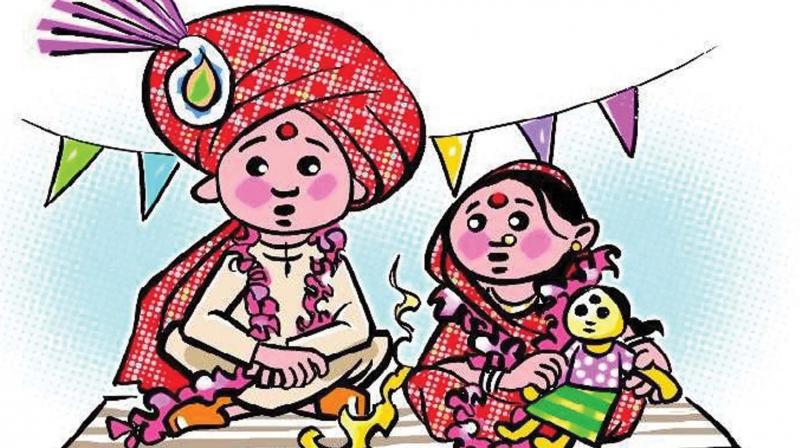Child Marriage in India Introduction
- Child marriage remains one of India’s most pressing social challenges despite various efforts to curb it.
- Recognizing the gravity of the issue, the Supreme Court has recently urged Parliament to consider amending the Prohibition of Child Marriage Act (PCMA) of 2006 to prohibit child betrothals altogether.
- The apex court emphasized that such practices infringe upon children’s rights to autonomy, free choice, and a dignified childhood.

What is Child Marriage?
- Child marriage refers to the formal or informal union of individuals under the age of 18.
- It violates the fundamental rights of children, denying them the chance to enjoy their childhood, pursue education, and shape their own future.
- While the practice predominantly affects girls, boys are also impacted, facing early responsibilities that hinder their growth and opportunities.
Current Status of Child Marriage
- Global Scenario:
-
-
- Globally, 40 million girls aged 15-19 are either married or in informal unions.
- According to Save the Children’s Global Girlhood Report, the COVID-19 pandemic has significantly increased the risk of child marriage, with an estimated 5 million additional cases expected between 2020 and 2025.
- 15 million children worldwide are at risk of never returning to school post-pandemic, making them vulnerable to early marriage, labor, and exploitation.
-
- India’s Situation:
-
- Data from NFHS-5 (2019-21) shows that child marriage rates in India have dropped to 23.3%, down from 47% in 2005-06. However, the progress is uneven, with states like West Bengal (41%), Bihar (40%), and Tripura (33%) exceeding the national average.
- India accounts for approximately one-third of the world’s child brides, with 16% of girls aged 15-19 currently married (UNICEF data).
Harmful Impacts of Child Marriage
- Violation of Rights:
-
-
- Child marriage denies the right to education, health, and protection from violence and exploitation.
- It infringes on personal autonomy and contravenes international conventions like the Convention on the Elimination of All Forms of Discrimination Against Women (CEDAW).
-
- Social Isolation:
-
-
- Girls are deprived of childhood and often confined to domestic roles, while boys face undue pressure to assume adult responsibilities early.
-
- Impact on Education:
-
-
- Early marriage forces girls to drop out of school, perpetuating gender-based illiteracy.
-
- Economic Consequences:
-
-
- Child marriage perpetuates an intergenerational cycle of poverty, limiting access to education and economic opportunities.
-
- Health Risks:
-
- Stunted Growth: Children of adolescent mothers are more likely to face malnutrition.
- Maternal Mortality: Girls under 15 are five times more likely to die from childbirth complications.
- Infant Mortality: Babies of teenage mothers face a 75% higher risk of death compared to those born to older mothers.
- Mental Health: Victims are prone to depression, anxiety, and PTSD due to abuse and isolation.
Why Does Child Marriage Persist?
- Poverty: Families struggling financially view marriage as a way to reduce economic burdens.
- Gender Inequality: Deeply ingrained biases treat girls as economic burdens and prioritize their marriage over education.
- Cultural Norms: Practices like dowry encourage early marriage to minimize costs, as dowry demands often increase with a girl’s age.
- Fear of Sexual Violence: Parents see marriage as a safeguard for their daughters’ safety and honor.
- Weak Enforcement: Laws like the PCMA, 2006, are not adequately enforced, and the lack of mandatory marriage registration perpetuates the practice.
Measures Taken to Address Child Marriage
- Historical Efforts:
- Reformers like Raja Rammohan Roy and Pandita Ramabai championed the fight against child marriage in the 19th century.
- The Sharda Act of 1929 was a landmark law setting the minimum marriage age at 14 for girls and 18 for boys.
- Legislative Steps:
- Prohibition of Child Marriage Act (PCMA, 2006): Criminalizes child marriage, with penalties including imprisonment and fines.
- Hindu Marriage Act, 1955: Specifies the legal marriage age as 18 for girls and 21 for boys.
- Additional protections include the Domestic Violence Act, 2005, and the POCSO Act, 2012.
- Government Policies:
- Beti Bachao Beti Padhao (2015): Focuses on empowering girls and addressing gender biases.
- State programs like West Bengal’s Kanyashree Scheme provide financial incentives to delay marriage and encourage education.
Way Forward
- Empowering Girls:
-
-
- Strengthen access to education with scholarships, better infrastructure, and sanitation facilities to encourage school attendance.
- Promote life skills programs to build confidence and independence.
-
- Strengthening Legal Frameworks:
-
- Ensure the effective enforcement of existing laws by training Child Marriage Prohibition Officers.
- Mandate marriage registration to curb illegal practices.
- Community Engagement:
- Conduct awareness campaigns to change societal attitudes and highlight the importance of delaying marriage.
- Involve religious leaders and local influencers in advocating for children’s rights.
- Economic Support:
- Provide livelihood programs and microfinance loans to alleviate poverty and reduce reliance on early marriage as an economic strategy.
- Innovative Models:
- Implement Child Marriage-Free Village certifications, inspired by Swachh Bharat’s Open Defecation Free initiative, to foster collective accountability.
- Engaging Men and Boys:
- Promote gender sensitivity programs to involve men and boys as advocates for girls’ education and against child marriage.















